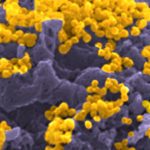Link to Pubmed [PMID] – 17056584
J. Immunol. 2006 Nov;177(9):6517-26
Desmogleins (Dsg) are transmembrane glycoproteins of the desmosome that allow a cell-cell adhesion between keratinocytes and comprise four different isoforms (Dsg1 to Dsg4). Two Dsg are targeted by pathogenic autoantibodies produced in the course of autoimmune bullous skin diseases, Dsg1 in pemphigus foliaceus (PF), and Dsg3 and Dsg1 in pemphigus vulgaris. The genetic susceptibility to PF is associated with certain HLA class II alleles, which are thought to participate in disease pathogenesis through their capacity to accommodate autoantigen-derived peptides and present them to autoreactive T cells. So far, a unique isoform of Dsg1 has been described in humans, which includes several immunodominant T cell epitopes. In this study, we describe an alternative transcript of DSG1, which contains a 101-bp insertion corresponding to the 3′ end of DSG1-intron 6 and introducing a stop codon in the nucleotide sequence. This alternative transcript leads to the synthesis of a truncated isoform of Dsg1 expressed in normal human epidermis. This isoform bears a specific peptide sequence that binds to the PF-associated HLA class II DRbeta1*0102 molecule as shown in a HLA-DR peptide-binding assay, and induces PF T cell proliferation. These data provide an illustration of an autoantigen encoded by alternative spliced transcript that may participate in the pathogenesis of the disease by bearing PF-associated HLA class II restricted-epitope.

